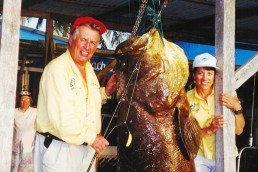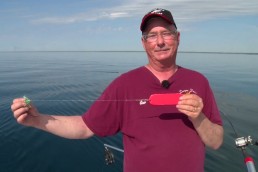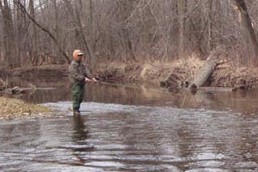Catching a World Record Intentional or Fluke?
SHARE THIS POST
Stumbling into record catches
Most record fish aren’t caught intentionally, but by accident. So it was with a fly-rod record pike I caught years ago. “Bobber” Anne and I were fishing the shallow waters at the mouth of the McFarlane River near Lake Athabasca in northern Saskatchewan. Here, in water no deeper than 2.5- to 4-feet deep, are large patches of cabbage weeds. Under a July sun, we sight-fished for big pike. Anne used a Walk-n-Lizard and I’d chosen a red and black Tantalizer Streamer Fly. I’d taken nine fish over 41 inches, my largest a 52-incher. Anne had equaled my catch, plus one. Her largest was nearly as long, a 51-incher. At that time, as the 52-incher was landed, I’d broken the fly rod world record twice with the 51-incher and the 52-incher.
We targeted large fish by pulling our baits away from any that looked less than 40 inches long. This method of selection caused me to stumble into the record. Pike, especially large ones, often race up under a surface lure such as the one Anne was using, and stop a foot away. Twitch the lure again, and they slam it hard.
I fished my fly much the same way. I’d cast within six feet of the targeted fish, allow the fly to sink, then retrieve it to the surface. The predator would cruise up to it. I’d allow it to sink again. The big pike would follow it down to bottom, his nose within inches of the fly. Once the fly hit bottom, its hair would float upwards. After about 20 seconds, I’d twitch the fly. This would be the signal for the pike to strike. We’d see the fish’s gills flare red as it sucked the fly into its mouth. I would wait a second, then set the hook.
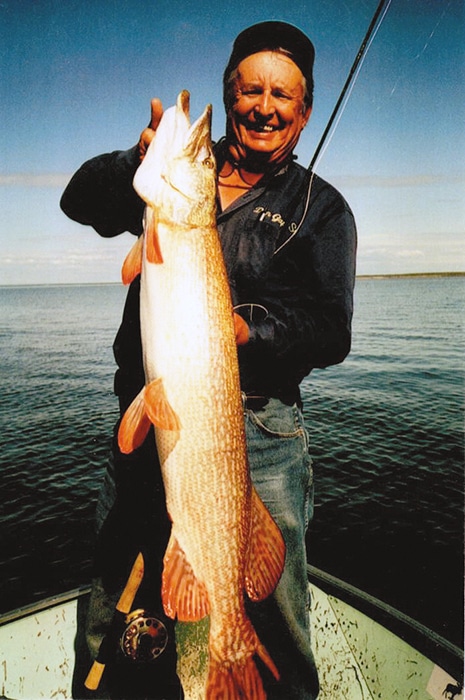
Picking off pike
My record pike came as I addressed a pair of 50-inch-plus pike that rested on the edge of a patch of cabbage. Both came after the fly. As the pike followed the sinking fly, another huge fish darted from the weeds unnoticed, and took it on the drop. This fish appeared as long as its two companions, maybe even longer. Anne, who was about to cast towards the other two, held off. My fish had raced back into the cabbage and was gathering pound after pound of weeds on my line. Our guide, Marvin, followed the hard-running fish as it headed for another weed bed.
Finally, as I applied pressure, the large pike settled into a 100- by 100-foot opening of deeper water where he would finally finish fighting me. Anne, bless her soul, had jumped into the water to gather photos during the battle, upon my request. Finally in the net, it measured 54.75 inches. Its tail was split, so we settled on 54.5 inches as its true measurement. It went into the records and still holds a top spot at that length, with a 24.5-inch girth and an estimated weight of 36 pounds.
I took another record with a 29.5-pound brown trout in Illinois water while trolling Lake Michigan for coho salmon. However, that record lasted just a week. A Chicago angler broke it by a half pound.
Sink your teeth in more stories of toothy-taking tactics.
Accidental snapper
Now, to prove my point, Anne has an official record saltwater fish, but quite by accident. It is a 67-pound cubera snapper from the waters of the Rio Colorado River in Costa Rica. I believe it still remains the world record on 30-pound line. Her guide was a local fellow, named Henry, working for Dan Wise, owner of Rio Colorado Lodge. Anne caught the big cubera snapper on a 3.5-ounce Bait Walker rig loaded with a chunk of yellowtail jack.
Anne also has an unofficial saltwater record: a 243-pound tarpon caught from the same river, but years before. At that time, you had to bring in the fish to have it officially recorded. That would have killed the fish. Also, since it was 8-feet long and alive, it would have trashed the boat and possibly broken some human bones. Anne had fought the fish for almost 2 1/2 hours. Once it was next to the boat, she said she’d like to release it. I was extremely proud of her. It was a shoe-in record, but she wanted it to live. She kept one big scale of it before she and Henry allowed it to slip back into the waters of the Rio Colorado. Anne truly displayed top-of-the-line angling ethics.
Sinker snagging snappers
Back to the snapper story. Our party of eight were fishing tarpon, one line with a Flub Dub plug running in the current, another on the bottom with cut bait for bottom fish. The record fish took Anne’s bottom rig and fought her for 2 hours and 15 minutes before it was landed. Normally, cubera snappers are caught in rocky reefs or sunken wrecks. Here at the mouth of the Rio Colorado, the bottom is sand and gravel with no obstructions to cut you off. The fact that large snappers are found here is unusual. Anne’s record could be considered an accidental fish.
Are you enjoying this post?
You can be among the first to get the latest info on where to go, what to use and how to use it!
One time, when Anne and I targeted cuberas, they cut us off 17 times on the wreck they inhabited. Even when we asked our guide to push the boat away from the wreck upon a strike, we would fail. Like large grouper, these wreck-holding snappers sought refuge inside the wreck when hooked, cutting us off each time. We kept trying until we ran out of lead sinkers.
Anne’s huge snapper was boated and kept, since we thought it was a record. Back at the resort, it was weighed on a certified scale and smashed the old record for 30-pound line by almost 20 pounds. Had she not been over the soft bottom of the Rio Colorado, her record would probably not have happened.
The giant goliath
I had a similar experience a hundred yards from where Anne took her world record. Twin channels run into the ocean from the Rio Colorado River. Anne caught her record snapper in the southern channel. I hooked a 310-pound goliath grouper in the north channel and fought her for 3.5 hours before landing her on a sand bar on the river’s south shore.
As before, we were running one rig for tarpon, another for bottom fish. This time, my bottom rig consisted of the center section of a yellow tail jack hooked up with a 14/0 hook behind a 10-ounce Bait Walker. That morning, Anne and I had helped a native family boat a 380-pound goliath grouper. It took all of us and our guide Gilbert to slide the monster into the family’s 25-foot-long canoe. How we did it still baffles me. But, I do remember the native dispatching the beast with an axe before getting it into the canoe. Then and there, a force rose in me. I wanted to pursue a fish like that.
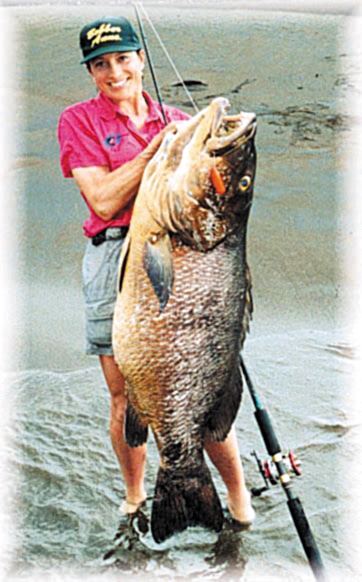
Man-eating fish
A point of interest about goliath groupers: most are believed to be born female. Then, when around 49 inches long, some turn male. It is one of six saltwater species with this trait. The largest goliath grouper this writer knows of was 980-pound monster caught by a loading crane on a dock in the port of Limon, Costa Rica. After a night on the town, several sailors disappeared on the way back to their ship when they fell through openings in the dock and into the water. Dock workers fashioned a huge hook and tied a small pig to it, believing an evil monster was under their dock.
They hooked this bait to a dock crane, which lowered the pig bait into the water. When the fish struck, she was hooked. The crane pulled her to shore where a truck hauled her out of the water. When cut open, the proof they’d caught their monster was validated as belly contents contained jewelry and skulls from the fish’s victims. As far as I know, the picture still hangs in the sailors’ bar at the end of the commercial 500-foot dock.
Record or no?
Forty minutes after dropping my 6-pound center-cut of jack to bottom, a huge fish hit and a long run ensued. After three-plus hours of battle, I managed to beach the beast. It took three guides to get it into our boat . It became wedged between the fighting seats and the transom. Back at the dock, it took a block and tackle, used to lift motors out of boats, to lift my prize to the scales. Official weight was 309 pounds, 9 ounces.
A record? Well yes, but no. It was caught on 40-pound line, for which there wasn’t a listing. The 30-pound line saw a record of 260 pounds. The 50-pound line saw 329 pounds as the record. So, readers, you be the judge. Did I catch a world record or didn’t I? The fish was kept, filleted and divided up among the people of the village of the Rio Colorado. Everyone had plenty of fish for dinner for a couple of days!
Considered one of the world’s leading river anglers, Dan Gapen, Sr. will continue to recount his past and recent adventures and offer up his knowledge to MidWest Outdoors readers. For more information call The Gapen Company at 763-263-3558, email them at gapen@gapen.com or visit them at Facebook @TheGapenCompany.
MWO
SHARE THIS POST
Did you enjoy this post?
You can be among the first to get the latest info on where to go, what to use and how to use it!
Dan Gapen
Considered one of the world’s leading river anglers, Dan Gapen, Sr. has shared his knowledge with MidWest Outdoors readers and viewers for more than 40 years. He is a member of all three Fishing Halls of Fame—International, National Freshwater, and Minnesota. He has an immense grasp of the world’s fisheries. He may be contacted at 877-623-2099.
@TheGapenCompany.
